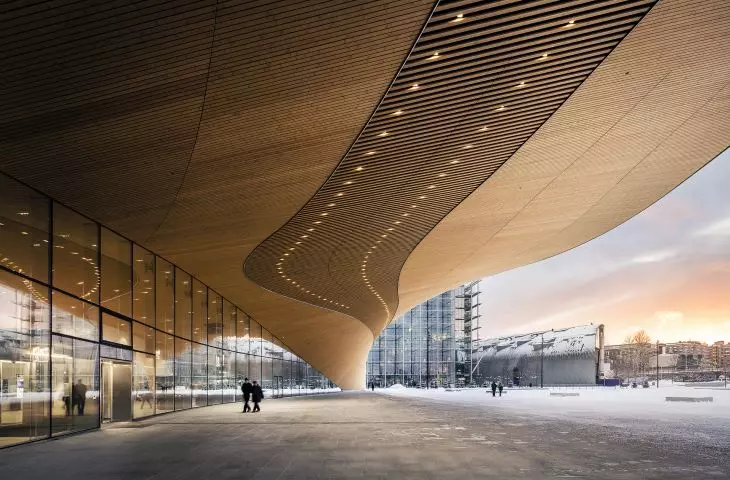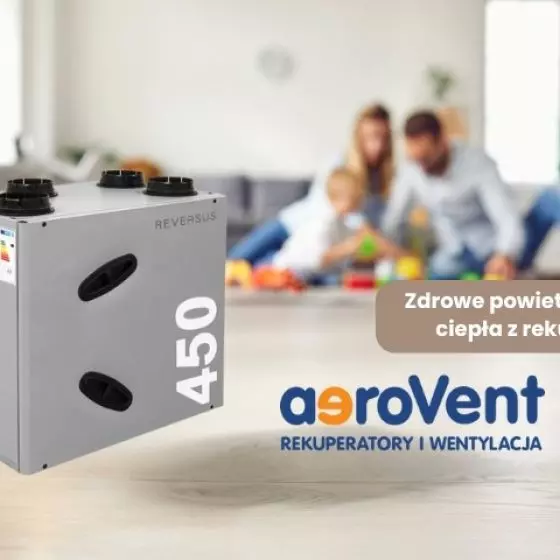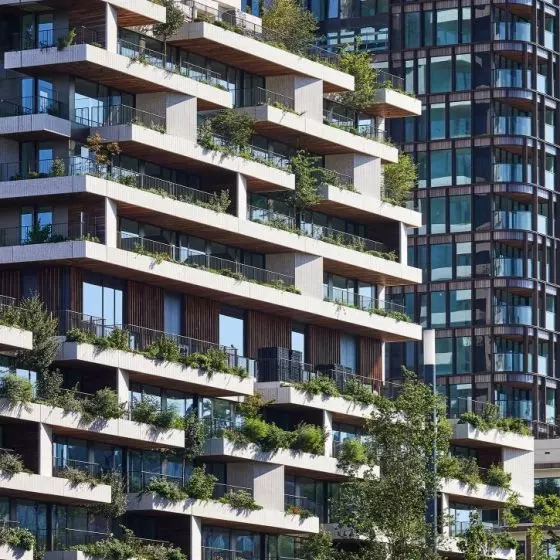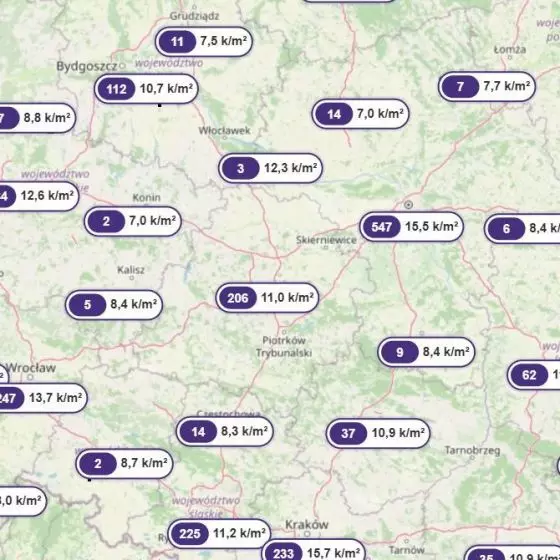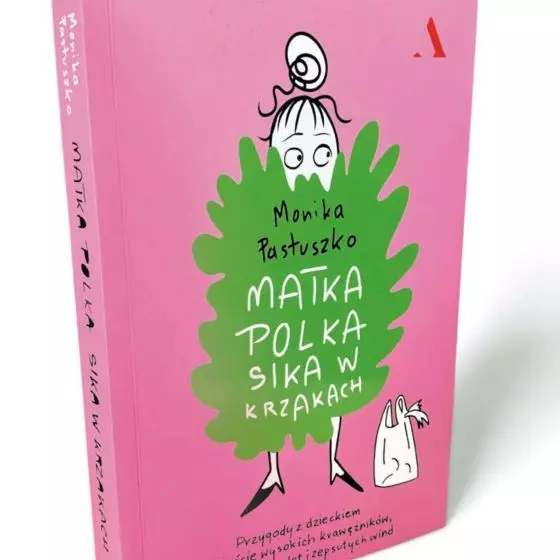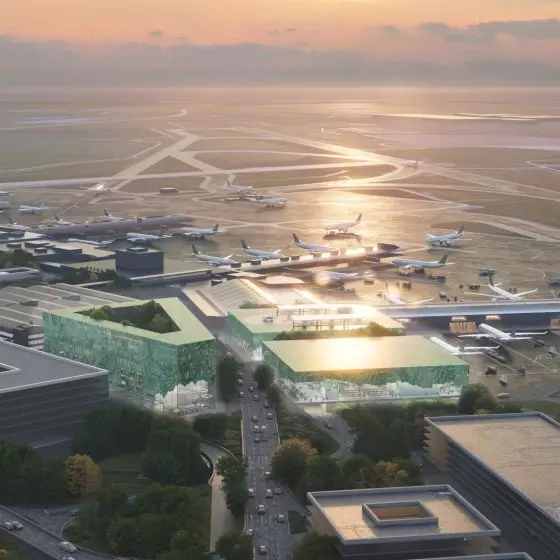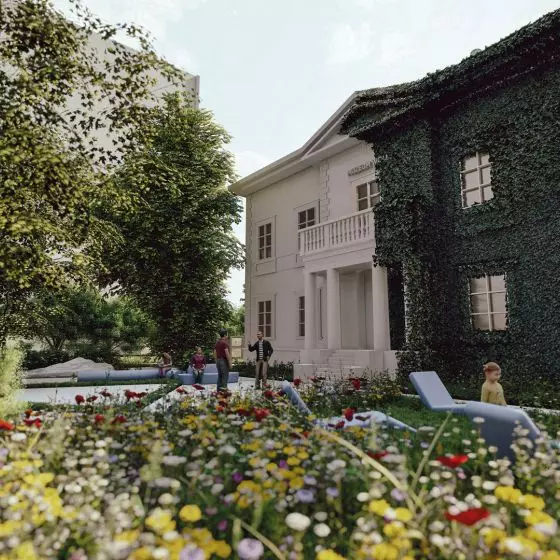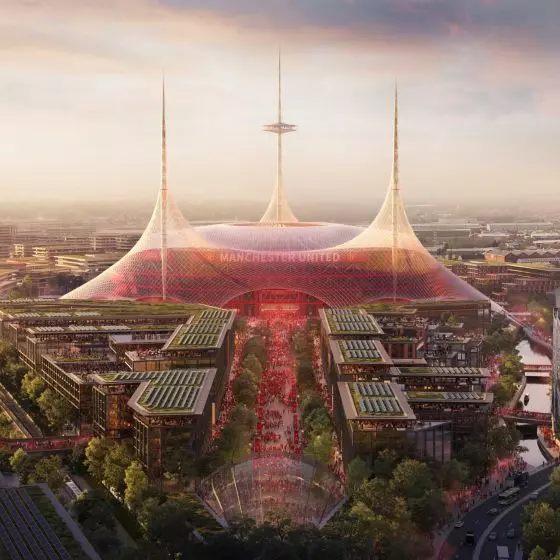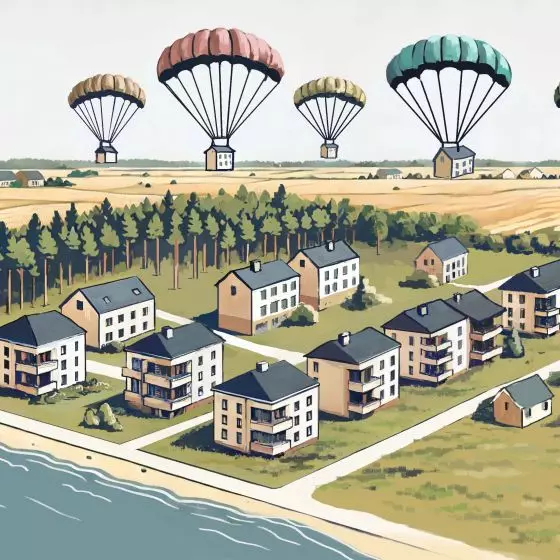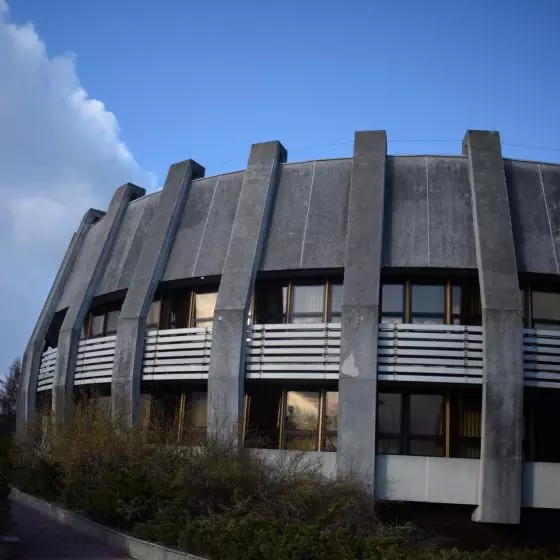The text is from the A&B 04 | 2022 issue
Helsinki - the capital of Finland, the northernmost metropolis in Europe, according to many rankings one of the best places to live in the world. The Baltic city boasts great air quality, a high sense of safety for residents or efficient public transportation. But Helsinki also has a weakness - it's undoubtedly a challenging climate. The average annual temperature here does not exceed 8 degrees Celsius, and snow cover persists even for more than 100 days a year! So it's no wonder that Finns attach great importance to any activity "under the roof". Suffice it to mention here the extraordinary popularity of sauna or ice hockey, but also the exceptionally developed reading culture.
In the country of a thousand lakes, book lending libraries still serve as local cultural centers and, despite the increasing digitization, cannot complain about a lack of visitors. Theimportance of libraries in Finland is also reflected in the local architecture. In the Helsinki metropolitan area alone, one can easily find outstanding buildings (in addition, from different eras), such as the National Library of Finland building (designed by Carl Ludvig Engel, Gustaf Nyström), the Harald Herlin Science Center (designed by Alvar Aalto, JKMM Architects) or the Kaisa University Bookstore (designed by Anttinen Oiva Architects). Finland, like Poland, recently celebrated a century of independence. The Finns decided to celebrate this anniversary, and how, by building another bookstore. On December 5, 2018, the new Oodi Central City Library by ALA Architects was inaugurated in Helsinki.
The front elevation of the edifice
Photo: Kuvatoimisto Kuvio Oy
a wave of success
Being an architect in a country that has given birth to such artists as Eero Saarinen, Matti Suuronen and Alvar Aalto is undoubtedly quite a challenge. However, contemporary Finnish designers are able to find their own original language of expression, making their mark not only on the country of a thousand lakes, but often abroad as well. In Poland, the best example of this is the POLIN Museum of the History of Polish Jews by the Lahdelma & Mahlämaki duo. Interestingly, the fate of another Finnish office, ALA, is also linked to Warsaw. In the famous 2007 competition for the Museum of Modern Art, their bold vision (created in collaboration with Group 5 and the artist Jaroslaw Kozakiewicz) was admittedly awarded a special honor, but many commentators at the time greeted the verdict with dissatisfaction. What failed in Poland, however, succeeded in Norway. For in Kristiansand ALA Architects completed a formally similar project - the Kilden Center for the Performing Arts, which began a string of successes for the young Finnish studio. Established in 2005 in Helsinki, the office is led by Juho Grönholm, Antti Nousjoki and Samuli Woolston. The company now has nearly 50 employees from 15 countries. The studio specializes in the creation of cultural buildings and transportation infrastructure, but also has a track record of successful renovations of historic buildings (including the pearl of modernism - the Finnish Embassy in New Delhi designed by Raili and Reima Pietilä Architects). ALA's most notable projects include theaters in Kuopio and Lappeenranta and a network of subway stations in Espoo. The architects also recently completed an expansion of Helsinki's airport, and are currently working on university buildings in Tallinn and Lyon, among others. An intriguing curiosity in the Finnish designers' portfolio is also... Revision Cloud's kraft beer, Architectural Pale Ale. The most important project in ALA's career to date, however, undoubtedly remains Helsinki's central city library - Oodi (the result of winning the 2012 open international competition, which received as many as 544 entries!).
Oodi library against the background of the Helsinki skyline
Photo: Kuvatoimisto Kuvio Oy
helsinki lesson
The investor of the new building is the City of Helsinki. However, the construction of the edifice would not have been possible without the financial support of the state (amounting to about 1/3 of the construction costs). Helsinki, due to its relatively short history (founded in 1550, the city developed only after taking over the capital role from Turku in 1812, and truly flourished after Finland's independence in 1917), does not have an excess of historical monuments. Not surprisingly, the Baltic metropolis prefers to look ahead with its thoughts, ambitiously aspiring to become one of the world's significant centers of design. A cultural district in the heart of the city, which has been consistently created for years, is to help it achieve this goal, with a new library to complement it. Oodi is the latest in a network of 37 branches of the city's bookstore. Interestingly, the adjective "central" refers more to the location and symbolism of the new library, rather than its role in the overall system, as the administrative offices or storage facilities remained on the outskirts of the city. The process of creating the building itself was also unusual, being a model example of design in the spirit of public participation. To begin with, a series of meetings collected more than 2,300 suggestions from Helsinki residents about their needs and expectations for the new building. Then, already during the architectural competition, in addition to the traditional jury deliberations, the public was allowed to vote on individual projects. The same was true of the final functional program, which was consulted with both the library community and the reading community. In addition, most of the construction and implementation work was entrusted to local companies, using mainly local materials. Finally, in accordance with a law in Finland providing for a so-called percentage for art in the budget of each new public building, 100,000 euros were also allocated for artists' works in the case of Oodi. The collective nature of the entire project is aptly summed up by the director of the bookstore, Anna-Maria Soininvaara: "Oodi is a project that was born out of a long and detailed exploration of the question: what a library can and should be. In consultation with our legislators, colleagues and users, we have jointly sought these answers, making democratic decisions that support the needs and respect the rights of everyone in our society." She is echoed by Helsinki Vice Mayor Nasima Razmyar: "Oodi is an exemplary example of a public library that was created to offer every citizen an open space with access to culture, freedom of expression and opportunities for self-realization. We hope that this palace of ideas will connect people and institutions and enable new interactions and experiences that will lead us to achievements greater than any achieved alone."
Oodi Library
Photo credit: Michal Haduch, Bartosz Haduch
heart of the city
In the Finnish capital, it would be hard to name a more prominent and prestigious plot of land than the one on which Oodi was built. This is because the library has grown up in the very center of the city, in the Kluuvi district, next to the vast park leading to Töölönlahti Bay. Around the bookstore one will find examples of unique, albeit heavily eclectic, buildings housing Finland's most important institutions. To the west, the new building is adjacent to the impressive Eduskuntatalo parliament building (designed by Johan Sigfrid Sirén) and the Helsinki Music Centre concert hall (designed by LPR Architects). Slightly further north rise: The National Museum of Finland (design: GLS) and the Finlandia Talo conference center (design: Alvar Aalto). Meanwhile, towering over the southern flank are the Kiasma Museum of Contemporary Art (design: Steven Holl) and the office building of Finland's most important newspaper Helsingin Sanomat (design: Jan Söderlund, Antti-Matti Siikala). And as if that wasn't enough, Oodi is barely a few minutes' walk from Helsinki's main train station - the work of Eliel Saarinen (Eero's father).
The double spiral staircase with the art installation "Dedication" by Otto Karvonen
Photo: TuomasUusheim
ALA architects approached such a complex context with respect, but without complexes. They planned the library, based on a trapezoidal plan, adjusting the height of the new edifice to the surrounding buildings. The designers of the building based the structure on two massive steel arches with a span of more than 100 meters, which may bring to mind the designs of bridge structures. Such a solution made it possible to free up the space of the first floor and the second floor, but above all it will enable the construction of a road tunnel planned under the building in the future. Oodi surprises with its intriguing sculptural form, as well as its bold choice of materials. The drawing of the building's facade is formed by three horizontal bands signaling separate functional zones in the building's interiors. The basement and the top of the library have been generously glazed (in the upper part of the edifice the panes have been additionally screen-printed, for better thermoregulation). The middle layer, however, as befits the most forested country in Europe (forests make up almost 3/4 of Finland's land area!), is filled with spruce boards 3.3 centimeters thick. This treatment can be interpreted as a nod to ancient Finnish wooden architecture or the local furniture-making tradition (with the famous bentwood products of Artek at the forefront). In the Oodi project, however, wood was used more imaginatively, which is particularly evident within the main entrance area covered by a "wavy" canopy.
Babel Library
The new edifice, on an area of 17,250 square meters, houses an interesting and varied program. The architects planned most of the functions on three main levels connected by elevators, escalators and an impressive staircase in the shape of a double helix. The latter is adorned with an interesting art installation called "Dedication" by Otto Karvonen, composed of 381 Finnish words selected by the public in an online vote. The first floor of Oodi was designed as an extension of the extensive urban plaza in front of the building. The ground floor space is thus filled mainly with support functions. Here you'll find a reception and information desks, a restaurant, an exhibition gallery, a conference space, and even the 253-seat Regina movie theater. The second floor, on the other hand, is mainly occupied by separate modules for developing various types of activities, both individual and group. These include a reading room, a recording studio, a photo lab, a photocopy shop, a 3D printing studio, computer game rooms, a sewing room, a meditation room, and even a culinary workshop kitchen! However, the real heart of the building beats on the second floor. It is here that a new home for more than 100,000 volumes has been created (however, part of the collection is stored in an underground sorting room and delivered upstairs using mobile robots when needed).
The interior of the library
Photo: Michal Haduch, Bartosz Haduch
The top floor is filled with open space, with an interestingly shaped artificial topography with two hills at opposite (north and south) ends of the room. Visitors' attention is drawn here by the white undulating ceiling (which may bring to mind a cloud), crisscrossed with circular skylights. Other elements of this interior design, however, are already much more traditional. Simple wooden floors, colorful carpets, classic white etalage, comfortable furniture (including the legendary hemispherical Ball Chair by Finnish designer Eero Aarnio) or trees in pots - all create a warm, homey atmosphere conducive to more than just reading. In addition to thematic zones dedicated to particular types of literature, the main room also houses several additional functions, such as a café and a playroom for the youngest. Complementing this unique space is an extensive outdoor terrace, which offers spectacular panoramic views of the surrounding area. The front of the building has a similar function, including a sports field, a mini skate park, a children's playground and a seasonal food garden.
* * *
Oodi is undoubtedly one of the most interesting library buildings built in recent years, not only in Finland or the Scandinavian Peninsula, but in Europe and perhaps even the world. The new bookstore impresses with its interesting exterior, but above all with its extensive and varied program. This is no ordinary book lending library, but an open, democratic space for discovering, trying and developing new activities (also with the help of technological advances). No wonder, then, that already in the first year of operation (though before the pandemic) the new facility received as many as 3 million visitors! It is worth noting that the building was created mainly from local materials, while maintaining the highest environmental standards (the facility was realized in accordance with the near-zero energy standard nZEB). Finally, the creation of Oodi has a certain symbolic dimension. The transparent building in the heart of Helsinki (opposite the parliament) shows the importance of education in Finnish society. However, there is also a spoonful of tar in this honey barrel. The top floor of the library definitely overshadows the other two floors of the building (especially the first floor space doesn't seem to use the full potential of the place). Critics of the project also point to the high cost of the edifice, reaching 98 million euros. The bold choice of facade materials also raises questions about the aging process of the building... However, regardless of differing opinions, ALA Architects' realization is an important, necessary voice in the discussion on the future of libraries.
Oodi - the name of Helsinki's bookstore - was chosen in an open competition. The word in Finnish means ode. It remains to be hoped, therefore, that the new library will bring much joy to Finns for many years to come, as befits the happiest country in the world....
The main library space on the second floor
Photo: Kuvatoimisto Kuvio Oy






